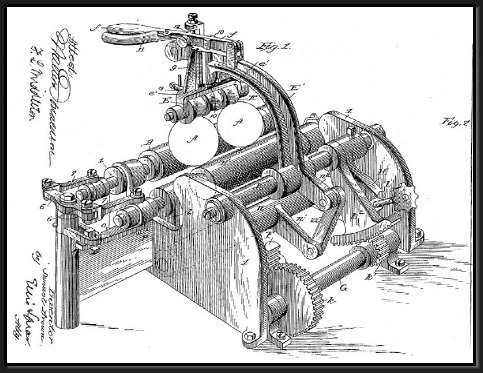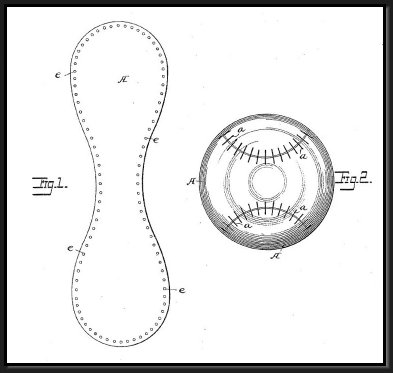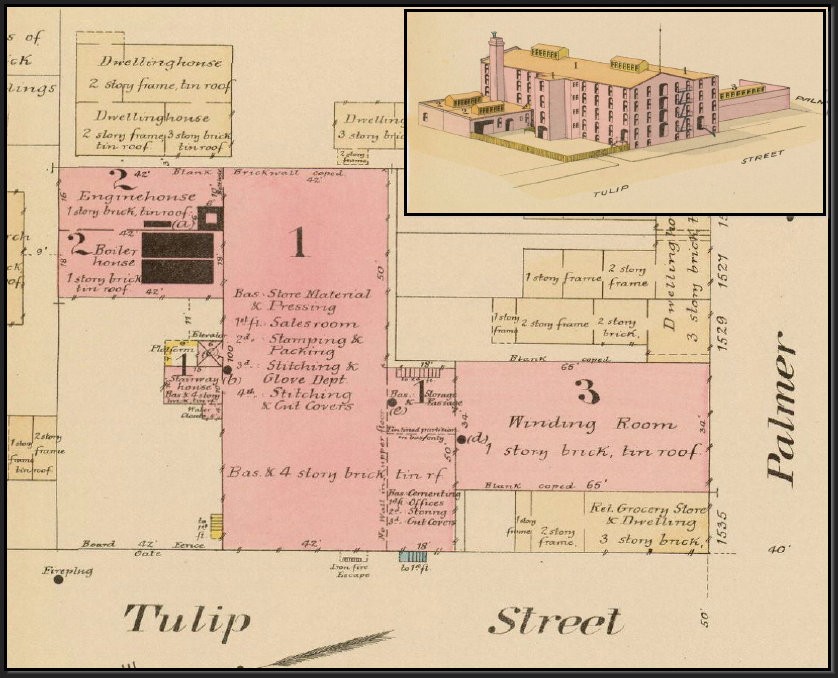
George A. Reach & Professional Boxing

Chris Hornung
February 20, 2018
Page 3
February 20, 2018
Page 3
Maker Spotlight:
The History of A.J. Reach & Co.
The History of A.J. Reach & Co.








Despite the ups and downs of professional baseball, Ben Shibe continued to advance manufacturing technologies that ensured A.J. Reach's monopoly on the production of professional and amateur baseballs in the United States. In 1888, A.J. Reach secured the patent rights to Samuel Brown's "Ball Winding Machine," which incorporated pressure rollers into a yarn winding apparatus, yielding a ball that was "solid and perfectly spherical." Then, in 1890, Shibe would be awarded Patent No. 442,147 for a baseball cover punch machine which would stamp the exact location of a baseball's 108 double stitches onto the horsehide cover. Prior to this innovation, workers punched each hole with an awl by eye, requiring an "expert operator in sewing." The new press enabled further standardization of the baseball and significantly reduced production costs by reducing the skill level required for ball stitching. With these new manufacturing processes A.J. Reach was able to inexpensively produce a wide variety of balls to meet demand at all levels of play.
From the time Al Reach's eldest son George joined A.J. Reach in the late 1880's, his focus was on expanding the company's footprint in a controversial sport that was nonetheless growing in popularity, boxing. Nineteenth century prize fights were brutal, bloody affairs fought bare-knuckled under the London Prize Ring Rules. After fights were banned in many parts of the U.S., promoters adopted the Marquess of Queensbury rules, which outlawed wrestling and required the use of gloves. In February 1890, James John "Gentleman Jim" Corbett defeated Jake Kilrain in a fight in which Corbett wore A.J. Reach's new five-ounce boxing gloves, the first to be used in a professional fight. Two years later, both "Gentleman Jim" Corbett and John L. Sullivan wore A.J. Reach boxing gloves, in a 21-round world heavyweight championship fight in New Orleans. Corbett's endorsement of Reach's gloves would help them become the preferred gloves of professional pugilists for decades to come.

Samuel Brown Ball Winding Machine Patent Illustration,
Patent Assigned to A.J. Reach, September 4, 1888
Patent Assigned to A.J. Reach, September 4, 1888
Benjamin F. Shibe, Base Ball Cover Patent Illustration, December 9. 1890

Baseball's skyrocketing popularity in the late nineteenth century was propelled not only by dynamic players and enterprising owners, but through a new generation of newsmen. Sportswriter Francis "Frank" Richter had a gift for storytelling using colorful metaphors and insider reporting to “spread the cult of baseball among the masses.” [11]. Through his involvement in the establishment of the American Association in 1882 and having served on the Joint Playing Rules Committee of the National League and American Association, Richter gained unparalleled access to team owners, managers and players. In 1883, he founded the Sporting Life which would become the leading weekly publication of baseball information in the U.S by the mid-1880's. By 1886, it had an estimated weekly circulation of over 40,000, a number which rose to 52,000 by 1890. In The Impact of Francis Richter Upon the Development of Baseball, Amber Shaw surmises, "Richter's Sporting Life served as the mouthpiece of the national pastime by providing commentary on league play, providing insight into the league's decisions and supplying its audience with records and historical information on the sport [11]."
Sporting Life Purchase
Advances in Manufacturing Technology
In 1892, A.J. Reach & Co. purchased the Philadelphia Knitting Mills building, a 4-story, 13,600 s.f. brick factory at the corner of Tulip and Palmer Streets in Kensington, for $35,000 and consolidated its manufacturing operation into the facility. The Free Library of Philadelphia online archives includes an 1893 Hexamer General Survey of the A.J. Reach "Base Balls & Sporting Goods Factory" which provides a snapshot of the company's manufacturing operation. In addition to increasing its baseball production efficiency, the factory enabled Reach to further expand its leather goods offerings, including a wider selection of baseball mitts and gloves, footballs, and boxing gloves. According to the Hexamer survey, the factory employed "200 to 250 hands" in 1893.

Kensington Factory
A.J. Reach Baseball Ad, Reach's Official Base Ball Guide for 1892
1883 was the high water mark for the Philadelphia Athletics. After only three years of existence, the team had won the American Association pennant (1883), and generated an estimated $200,000-$300,000 for its owners [9]. The American Association, however, would always play second fiddle to the better-financed National League, whose teams constantly raided the American Association of its best teams and outbid them for the best players. As a result, American Association teams had difficulty building fan loyalty and maintaining profitable attendance levels.
At the same time, many of the game's best players had grown increasingly disgruntled with their lack of rights in negotiating contract terms with league owners. Players formed the sport's first union, the Brotherhood of Professional Base-Ball Players in 1885 under the leadership of John Montgomery Ward, and in 1890, left the National League to form a third professional baseball league, the Players' National League of Professional Base Ball Clubs. A prominent Philadelphia businessman, J. Earl Wagner, entered a team into the new Players' League in 1890.
Although the Players' League folded after one year, a third professional baseball team in Philadelphia was a death sentence for Sharsig's Athletics. The team, left robbed of its players by both the National and Players' League, lost its final 21 games of the 1890 season, was expelled from the American Association, and folded shortly thereafter. Not only did Shibe lose his financial investment in the club, A.J. Reach Co. would lose a major source of advertising and revenue when the remaining American Association teams were absorbed into the National League in 1891.
At the same time, many of the game's best players had grown increasingly disgruntled with their lack of rights in negotiating contract terms with league owners. Players formed the sport's first union, the Brotherhood of Professional Base-Ball Players in 1885 under the leadership of John Montgomery Ward, and in 1890, left the National League to form a third professional baseball league, the Players' National League of Professional Base Ball Clubs. A prominent Philadelphia businessman, J. Earl Wagner, entered a team into the new Players' League in 1890.
Although the Players' League folded after one year, a third professional baseball team in Philadelphia was a death sentence for Sharsig's Athletics. The team, left robbed of its players by both the National and Players' League, lost its final 21 games of the 1890 season, was expelled from the American Association, and folded shortly thereafter. Not only did Shibe lose his financial investment in the club, A.J. Reach Co. would lose a major source of advertising and revenue when the remaining American Association teams were absorbed into the National League in 1891.
Mysterious Partnership
Philadelphia Times, November 20, 1889
In the summer of 1889, A.J. Reach reached an agreement to sell its retail business and stock at 1022 Market Street to A.G. Spalding & Bros for $50,000. The store, which would be Spalding's third in the U.S., reopened as an A.G. Spalding & Bros. retail store in November, 1889. According to newspaper reports, the transaction did not include Reach's sporting goods manufacturing and wholesale business, which Reach and Shibe would continue to operate independently. However, it is likely that the 1889 Reach-Spalding agreement included the framework for Spalding's clandestine acquisition of A.J. Reach & Co. in its entirety. An 1888-1906 A. J. Reach Company Executive Minutes Book, sold by Robert Edwards Auctions in 2013, shows A.G. Spalding owning 500 of 977 shares of A.J. Reach stock in 1890, and 995 of 999 shares by 1892.
In 1892, A. G. Spalding acquired another east coast competitor, Wright & Ditson, from Spalding's friend George Wright. The acquisition gave A.G. Spalding & Bros. control of well over 75% of the U.S. retail athletic goods market. The details of the agreement between Spalding, Reach, and Wright remains a mystery. One possibility is that Reach, Shibe, and Wright were given A.G. Spalding stock in exchange for the sale of their companies to the conglomerate. Regardless, in what was likely an attempt to avoid prosecution under the Sherman Anti-Trust Act of 1890, the Spalding acquisitions weren't made public for decades and all three companies would remain in business, appearing as independent competitors selling their own lines of sporting goods. Al Reach and Ben Shibe would continue to oversee production of A.J. Reach equipment, and according to later sources, manufactured baseballs and other sporting goods for both A.G. Spalding & Bros. and Wright & Ditson. A 1936 article in The Sporting News repeated the claim that "The official American and National league balls, one bearing the Reach trademark and the other the Spalding trademark, are virtually identical in construction and both have been made at the Reach plant here for years. "Spalding bought much of his equipment from Reach... The result was that the interests of the two major league players eventually merged - Reach made and Spalding sold."
In 1892, A. G. Spalding acquired another east coast competitor, Wright & Ditson, from Spalding's friend George Wright. The acquisition gave A.G. Spalding & Bros. control of well over 75% of the U.S. retail athletic goods market. The details of the agreement between Spalding, Reach, and Wright remains a mystery. One possibility is that Reach, Shibe, and Wright were given A.G. Spalding stock in exchange for the sale of their companies to the conglomerate. Regardless, in what was likely an attempt to avoid prosecution under the Sherman Anti-Trust Act of 1890, the Spalding acquisitions weren't made public for decades and all three companies would remain in business, appearing as independent competitors selling their own lines of sporting goods. Al Reach and Ben Shibe would continue to oversee production of A.J. Reach equipment, and according to later sources, manufactured baseballs and other sporting goods for both A.G. Spalding & Bros. and Wright & Ditson. A 1936 article in The Sporting News repeated the claim that "The official American and National league balls, one bearing the Reach trademark and the other the Spalding trademark, are virtually identical in construction and both have been made at the Reach plant here for years. "Spalding bought much of his equipment from Reach... The result was that the interests of the two major league players eventually merged - Reach made and Spalding sold."
Frank Richter, c. 1900
REFERENCES
